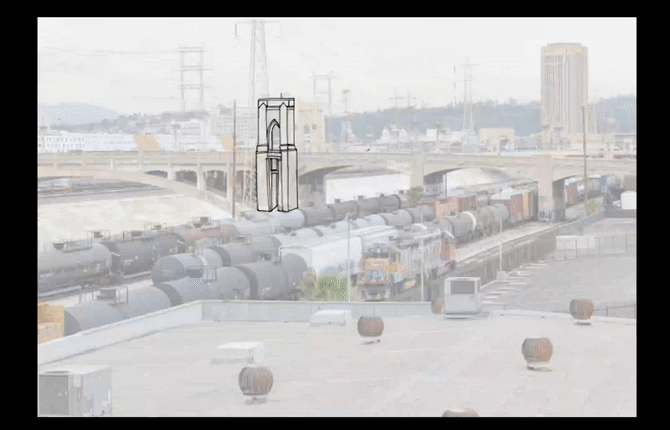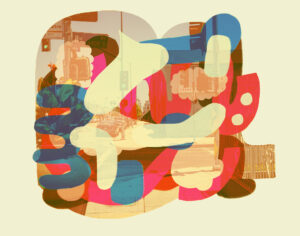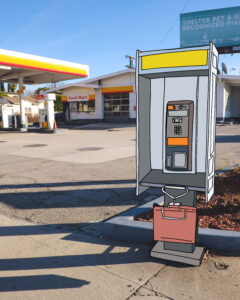Kwasi Boyd-Bouldin is a multi-genre artist and designer. His oeuvre includes photography, illustration, painting, graphic design, and so much more. Within this issue of Exposition Review, we see his styles unfold with an original photo illustration featured on our cover, a documentary landscape photo journey through Los Angeles within the issue, and works in other forms that illustrate this interview.
Documenting neighborhoods in Los Angeles is the foundation of his practice, and the full expression of that practice can be found on his website/production entity Nonstndrd Creative, through which he puts out yearly zines and books. This year, he will publish books, including a new version of his street photography series The Public Work and a book of artwork called Secret Schematics.
Boyd-Bouldin was one of the inaugural Los Angeles Public Library Creators in Residence and the lead photographer for the Netflix animation series City of Ghosts, where his photographs were used for the backgrounds of the show.
Expo editors Ramona Pilar and Brianna J.L. Smyk got to Zoom in with Kwasi about his multi-genre art and creative practice in Los Angeles.
Exposition Review: How did your styles emerge, and how did you get to the photograph and illustration combination we see on our cover?
Kwasi Boyd-Bouldin: As a kid, I always drew. I wasn’t really into photography super young. My dad passed away when I was nineteen. I got into photography using a camera that he had left me, and I ended up getting serious about photography in my early to mid-twenties. All up until that time, though, I was really focused on being an illustrator, graphic designer—graffiti, skateboard culture, all of that stuff.
Then for a long time after that, photography became more and more part of something that I did, but I didn’t really cross them at all. I did my design stuff. I did my art stuff or my illustration stuff. And then I had photography, [which] was mostly landscape documentary. I didn’t really see a way to connect those dots.
Fast-forward to more recent times, a couple of things happened that caused me to reconsider that. One was working on City of Ghosts, an animation project using my photography. You would see what they were doing with it, and I was like, “Huh!” I always wanted to blend it, but I didn’t want to be corny—I didn’t want to just have a drawn character in a photographic background. I felt like that would just cheapen both mediums for me, and I really took especially the documentary landscape side of things seriously.

Then the pandemic hit literally immediately after City of Ghosts, like the day we ended, and I had the gift of time, so I decided to tackle this challenge that has always eluded me: How am I going to tie these worlds together? Let me use the skills I have like hand drawing, outlining things, and just experimenting, and it culminated with the project I did for the [Los Angeles Public Library] with The Library Zine. That was the first project that I decided to go all out with this style. Not just as something I’m going to post on my Instagram. I can put it out there as part of my portfolio and people would respond to it in a positive way.
ER: Is this photographic illustration style one you’ll use exclusively moving forward?
KB: I definitely feel like I found a style. Especially with my illustration and design stuff, I have a lot of different things that I like doing: I enjoy drawing characters and abstract things and shapes and things that are not recognizable. Abstractions are a big part of my fine art in a lot of ways. The style [of] the cover and LAPL stuff—that’s very much a design thing, and there is a little bit of a difference in terms of how I categorize my fine art and design. I would put my photography without an illustration and my abstract work as my fine art. But I would put the LAPL illustration style in particular as design, because there’s an intent to make things up. That may change a year from now, but as for right now, that’s how I feel about it.
ER: How do you choose your subject matter?
KB: When I think about subjects and I think about areas and places to photograph, it involves a lot of self-reflection, and it involves a lot of what I see as L.A. I’ve grown up here. I’ve lived in a lot of different neighborhoods. I’ve seen a lot of how things change. I have a visual reference set for how things have evolved. So when I’m out looking at things, I really rely on that visual reference, that history that I have. And what I try to do with my photography is to grab those pieces, those places, those elements and string them together into a sense of place that is recognizable to people that live here, but also maybe not what people think L.A. is.

That’s the core of my photography, and by extension, it’s the core of the illustrations that I do on my photography also, because that’s another way to zero in on even more specific elements. I can take elements from one place or another and make those into something else. I can make a collage that’s representative of an area because it has these elements from the area, but it would look like an abstract line drawing or an architectural jumble. If you know what you’re looking for, you can see it. But there’s not really a narrative. The only narrative is “Real L.A.,” whatever that means—just a recognizable L.A. to people that live here. Not always an outward-facing L.A., but an inward-facing one too.
ER: How does that knowledge of what is commonly perceived to be L.A. inform how you present L.A., and why you want to present it the way that you do?
KB: When I was younger, I was really into skateboarding. I got into skateboarding when I was like ten and I basically skated off and on until I was twentysomething. I started skating in Mid City, which isn’t a place that people normally associate with skateboarding. Especially when I started, it wasn’t what you saw in magazines or anything like that. So there’s always been that, “I will do this, but it doesn’t look like what people think it is.” It was just L.A. We didn’t fit any sort of profile.

That’s always been a theme in my life—that there’s this L.A. that I’m so comfortable with that is kind of like a small town, especially if you’re from here. It’s super diverse. There’s all these different cultures that live separately but together and overlap. And none of that is represented in media or in any sort of outside perception of L.A. at all. They tend to push that version of L.A. to the outskirts, and they tend to focus on the glossy glitzy accessible L.A.
That tension has always been there for me, and especially with my photography, that was really a driving force. My focus on neighborhoods is one of familiarity, and obviously there’s some nostalgia that goes into it, but really, I like presenting them in a way that people [who live here] recognize. It’s not fancy. Sometimes it’s not glossy or glamorous, but it’s real and it’s cultural and in so many ways, it fuels the external L.A. that people perceive. That tension really fuels [my work]—a sense of pride and also a desire to show things accurately.
ER: You use a lot of figures in your abstract and fine art work but not in your photography. Why is that?
KB: When it comes to the people that I draw or incorporate into my abstract stuff, [that comes from] a lifetime of taking public transit. It’s wandering around. I like faces. I like people. I have people that I see, and those are people that I like to draw.
But I don’t really like taking pictures of people like that outside. One, there’s all sorts of privacy stuff. Two, I consider myself a street-level photographer, and in that way, I don’t want to trip people up. I don’t want to document anything that might get somebody burnt. Not only is it bad karma, it draws negative attention to you. I want to be there as part of what’s going on and just document it in ways that are visible but not really a focus on one particular person doing one particular thing.
As soon as you see a face in the photograph, it’s about the face and not about the place. Using the location as a container, as the frame, as the actual composition, and then waiting for people to interact with that composition—that’s my vibe. It’s taken me a really long time to get to that though. In my early work, there’s no people at all. And then it really settled into the style I have now where I feel really comfortable in terms of the balance between [a work] being a landscape photograph and there being people in it, but more of a landscape photograph than a street photograph.
Lately, I’ve been moving a little bit out of the urban sphere into the more natural environment, casting a little bit of a wider net and trying to take the natural environment into the work I’ve done so far. Because people as part of the environment is the point.
ER: How does working in a natural environment differ from your urban work? Do you see a link between depicting Black neighborhoods and documenting Indigenous land?
KB: I grew up in basically Koreatown, Mid City, and Hollywood for the first thirtysomething years of my life. Recently I moved to Studio City [in] a very green area right by the L.A. River. It’s not the L.A. River that I saw as a kid where it’s paved. No, there’s a manicured Valley Creek Walk, and I walk my dog there and see great herons and hawks and stuff like that. Malibu Creek is twenty minutes away. Topanga State Park is twenty minutes away. Franklin Canyon is five minutes away. All of these places are really accessible to me now. And not only is accessibility something that really drives my creativity, but also the difference between where I grew up and the lack of nature, and the beautiful overwhelming abundance of it where I live now, is really stark. It’s really something that has hit me in a prominent way. I think about it every time I go outside.
That aspect of it is one part of it, and then it’s really been very prominent to me that we live on Indigenous land and the United States is built on Indigenous land. At the same time, I’ve been able to trace a lot of my family history back to slavery [on] both sides of my family and specific locations in Georgia. On my mom’s side, we’re Geechee from the islands that are off of Georgia. [This is] just knowledge that contributes to this picture I’m painting—not always in concrete ways, and not always in ways that I can really express, but it is encouraging that it’s picked up, and that people can look at it and make these connections. I’ve always felt that’s how art works.
That’s actually the connection between my photography and my abstract work. My abstract work has all of these things in it, too—it’s just I tried to communicate it in a way that’s not necessarily representational. You know, it’s all vibe. And with my photographs, I always strove to take pictures that resonate where people may think they’re simple pictures, but if you know the context, or you know the block, or you know this or that, they’re actually much more complicated than they seem initially.

ER: What are the differences between creating for smaller projects, like your ongoing “Black Space” project, and larger projects that you’ve worked on, like the Netflix series City of Ghosts?
KB: One, the larger ones pay. Money’s always a factor. But money is a factor because with money comes expectations. Working on City of Ghosts stressed me out. Not because of the cast or the crew or the director—everyone was great. I really hit my stride in the middle of the series where I wasn’t absolutely nerve-racked every time they called me about something. But the first two [to] three shoots, I was taking all of these pictures, and I didn’t know if I was doing it right, because honestly, no one’s really done what we’re trying to do. So I was taking pictures and just giving them to people and trusting that they would do the right thing. My mind was blown because they more than did the right thing. They really nailed it in a way that I felt brought out the best of the work that I submitted. But it was stressful.
Also, there’s the element of time. On a project like “Black Space,” I have all the time in the world because it’s my side project, but I also don’t have all the time in the world because it’s not paid. And because it’s not paid, I can’t just set aside a bunch of time to do it because I can’t feed my children with my ambition.
But I can say that the exception to that was what I did with the library, because what I did with the library was both the most lucrative thing I’ve done independently from a financial standpoint, but also the project that had the least directives. They were just like, “Do something and make it about the library.” And I was like, “Alright, cool.” And then within that they were like, “Challenge us.” And I was like, “Are you sure?” And they were like, “Yeah.” And I was like, “Alright, because I got ideas.”
And honestly, they ran with everything I threw at them. That project was six months of “I have the time to do this. It’s paid me in a way where I don’t have to take freelance projects.” I just focused on making this work and I’m really proud of the library zine and the book, Knowledge Based, that I was able to put out. But I’m also really proud of the 1,200 to 1,300 extra shots that no one’s ever seen that I just have in my archive now. That’s a big, big thing, and it also helped me solidify the style, that linear architectural style. That was really the testing ground. I was like, “OK, can I do this? Can I do this for seventy-three branches? Yeah, I can.” And that was an experience in itself.
ER: You have so many artistic styles—do you consider writing as one of them?
KB: I do like to write, although I don’t consider myself a writer. It used to be a bigger part of my portfolio, where I would write things that went with the photo essays, and I purposely pulled back on that a little bit just to save it for a story that needs to be told. The “Black Space” project has writing, but that’s by my nephew Tyree Boyd-Pates. I edit it, I do change some sentences, but that’s all him.
ER: Thanks so much for chatting with us. Any final thoughts?
KB: Really when it comes down to it, I try to communicate things about like my life in L.A. and about life in L.A. from my perspective, not because my perspective is necessarily super important or better than somebody else’s perspective, but just because it’s a perspective, and it’s the only one I have. It’s really all I can do.
This interview has been edited for clarity and length.